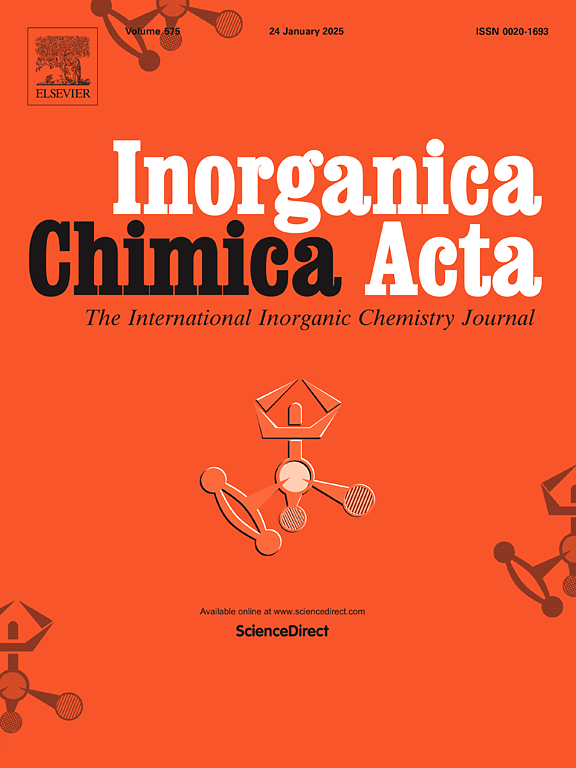Structural and spectroscopic characterization of Zn(II) complexes: A computational perspective on anticorrosion potential of bronze surface
IF 3.2
3区 化学
Q2 CHEMISTRY, INORGANIC & NUCLEAR
引用次数: 0
Abstract
The coordination of Zn(II) carboxylates with nitrogen donor ligands significantly influences the physicochemical properties of metal complexes, due to their structural diversity. Herein, we report the synthesis and characterization of Zn(II) heteroleptic complexes with the general formulae [(L1)2Zn(bipy)] (1), [(L2)2Zn(bipy)] (2), [(L3)2Zn(quinoline) (H2O)] (3), [(L4)2Zn(quinoline) (H2O)] (4), and [(L5)2Zn(quinoline) (H2O)] (5), where L1–L5 represent benzoic acid or phenyl acetic acid derivatives, and bipy denotes 2,2-bipyridne. All complexes were thoroughly characterized using FTIR, UV–vis, and 1H/13C NMR (for complexes 3–5 only). The structures of 1 and 2 were further confirmed by single-crystal X-ray diffraction. All complexes are mononuclear, incorporating two carboxylate ligands. Complexes 1 and 2 contain one 2,2′-bipyridine ligand, while complexes 3–5 feature a quinoline ligand and a water molecule. Most of the complexes adopt hexacoordinated structures. However, complex 1 is tetra-coordinated, exhibiting a distorted tetrahedral geometry. Various coordination modes are observed, including both monodentate 1, a combination of monodentate and bidentate (3–5), and both bidentate coordination 2. All the complexes were optimized for their HOMO/LUMO energy by using DFT![]() D. The anticorrosion ability of all complexes was evaluated by Monte Carlo (MC) and molecular dynamics (MD) simulations. MC and MD simulations of complexes 1–5 on the bronze (100) surface, along with negative adsorption energies, reveal strong first-layer localization through both chemisorption and physisorption. The degree of adsorption of complexes 1–5 follows the order 3 > 2 > 5 > 4 > 1.
D. The anticorrosion ability of all complexes was evaluated by Monte Carlo (MC) and molecular dynamics (MD) simulations. MC and MD simulations of complexes 1–5 on the bronze (100) surface, along with negative adsorption energies, reveal strong first-layer localization through both chemisorption and physisorption. The degree of adsorption of complexes 1–5 follows the order 3 > 2 > 5 > 4 > 1.

锌(II)配合物的结构和光谱表征:青铜表面防腐电位的计算视角
Zn(II)羧酸盐与氮供体配体的配位由于其结构的多样性而显著影响金属配合物的物理化学性质。本文报道了具有通式[(L1)2Zn(bipy)](1)、[(L2)2Zn(bipy)](2)、[(L3)2Zn(喹啉)(H2O)](3)、[(L4)2Zn(喹啉)(H2O)](4)和[(L5)2Zn(喹啉)(H2O)](5)的Zn(II)杂电配合物的合成和表征,其中L1 - L5表示苯甲酸或苯基乙酸衍生物,bipy表示2,2-联吡啶。所有配合物均通过FTIR, UV-vis和1H/13C NMR(仅针对配合物3-5)进行了全面表征。单晶x射线衍射进一步证实了1和2的结构。所有的配合物都是单核的,包含两个羧酸配体。配合物1和2含有一个2,2 ' -联吡啶配体,而配合物3-5含有一个喹啉配体和一个水分子。大多数配合物采用六配位结构。然而,配合物1是四协调的,表现出扭曲的四面体几何。观察到多种协调模式,包括单齿1,单齿和双齿结合(3-5),以及双齿协调2。利用DFTD对所有配合物的HOMO/LUMO能量进行了优化。通过蒙特卡罗(MC)和分子动力学(MD)模拟对各配合物的防腐性能进行了评价。配合物1-5在青铜(100)表面的MC和MD模拟,以及负吸附能,揭示了通过化学吸附和物理吸附的强第一层定位。配合物1-5的吸附度为3 >;2比;5比;4比;1.
本文章由计算机程序翻译,如有差异,请以英文原文为准。
求助全文
约1分钟内获得全文
求助全文
来源期刊

Inorganica Chimica Acta
化学-无机化学与核化学
CiteScore
6.00
自引率
3.60%
发文量
440
审稿时长
35 days
期刊介绍:
Inorganica Chimica Acta is an established international forum for all aspects of advanced Inorganic Chemistry. Original papers of high scientific level and interest are published in the form of Articles and Reviews.
Topics covered include:
• chemistry of the main group elements and the d- and f-block metals, including the synthesis, characterization and reactivity of coordination, organometallic, biomimetic, supramolecular coordination compounds, including associated computational studies;
• synthesis, physico-chemical properties, applications of molecule-based nano-scaled clusters and nanomaterials designed using the principles of coordination chemistry, as well as coordination polymers (CPs), metal-organic frameworks (MOFs), metal-organic polyhedra (MPOs);
• reaction mechanisms and physico-chemical investigations computational studies of metalloenzymes and their models;
• applications of inorganic compounds, metallodrugs and molecule-based materials.
Papers composed primarily of structural reports will typically not be considered for publication.
 求助内容:
求助内容: 应助结果提醒方式:
应助结果提醒方式:


